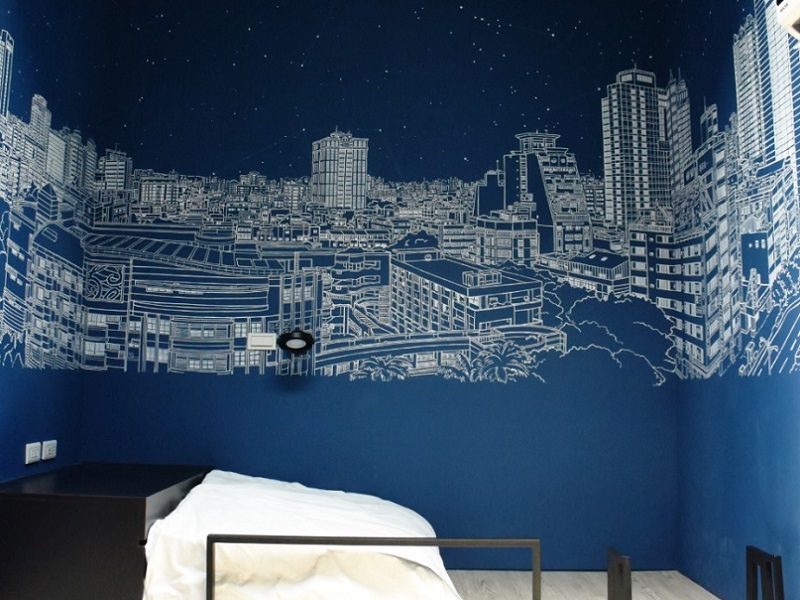Experiencing the Unknown: In Style House, Kaohsiung
by Qian Leung
@ 27 Sep 2018
 In Style House
In Style House, located a two-minute walk from Sinyi Elementary School Station, is a terraced house built in 1978. As the house is formed of five stories, it would probably have been home to a family of three generations: they may run a small business on the ground floor, with the grandparents staying on the second floor, the oldest son and his wife and children on the third, and so on. Today, the building has been turned into an inn by an emergency room doctor who loves travelling himself.

“I hope that when you stay at In Style House, it feels like home,” says Eason Wu, 40. Leveraging on the strengths of an old friend from elementary school days, the interiors have been designed to be bright and airy, with an element of style. “The sketch of white against blue beneath the sky window is done by him, with help from three other friends.” It took one month to transfer the illustrations, which were made from the rooftop, to the wall. To get to the loft where the panoramic wall mural is, you need to climb up a ladder past two bunk beds.
With its rope netting, and an ultra-high ceiling created by knocking away the floor between the forth and the fifth, the little platform feels like a tree house sitting under a night sky. There are six beds in this room, each with its own lamp and curtain. On the same floor is a room decorated in a whimsical theme, with a house-shaped four-poster bed, stuffed toy foxes, and a curtain of medieval European castles.
In the corridor, an entire wall has been partitioned into boxes. What catches my eyes is a boy bursting with pride over his bunch of bananas. Did you know, that an hour’s ride north of Kaohsiung is a town named Qishan, where you can find bananas made into chips, egg rolls, bread, cakes, cream puffs, and even ice cream and ice blends? Vintage shoemaking forms, a telescope for stargazing, and books about old and new Kaohsiung complete the collection.
Where wooden partitions and concrete stairs once were, a series of steps now float upwards, allowing light to stream in from the sky window and illuminate each floor. “As the main windows face south, and the back doors face north, it becomes cooling when we keep them open,” says Wu, pointing out the prevailing wind directions. Also composed by his old friend is the line drawing of white on black on the third floor. “We thought it’d be fun if, when guests came back after a day out, they can recognise the places they’d been to.”
My attention is drawn to the black bears, which may be taking a selfie, operating a vintage camera, riding a trishaw, flying a kite, relaxing in a hot spring, holding a baseball bat, or carrying armloads of shopping bags. Formosan black bears, which are distinguished by their white collars, used to roam the mountains of Taiwan. The loss of natural habitat has driven the species to an endangered status.
Camouflaged as part of the drawing is the doorway to a room with two double beds, done up in classic country style, with checkerboard wooden flooring, drop-front writing desk, and framed pages of doodles from a trip to New York City and California, drawn by the same friend. Also on this level is a small and cosy room with bunk beds, which is popular with friends or siblings travelling together. The second floor is composed of the innkeeper’s office, a front desk, and a space which can be used for an exhibition, a seminar, or small gathering.

Perhaps as a result of his own experiences from travelling, Wu decided to install a washing machine and drying lines on the balcony, so guests can do their laundry. “In Japan, a washer and a dryer can be found in almost any inn you stay in,” says Wu. He also selects towels, beddings, shower gel, shampoo, and slippers made in Taiwan. “We want everything that touches your skin to be made in Taiwan.” The western region of Taiwan known as Yunlin used to be the hub for towel manufacturing in the 1980s, until an influx of cheap goods from overseas in 2002 forced many to close. Today, the remaining towel makers differentiate themselves by focusing on quality.
For me, my best memory of In Style House is conversing with the innkeeper, who shares with me fascinating stories about her days of solo-travelling around the world. “I enjoy my job because I get to meet people from different cultures,” she says. A chat with her and a stay in In Style House is sure to reawaken your wanderlust.
Adapted from the
Sep Oct 18 issue of Cuisine & Wine Asia.
 In Style House, located a two-minute walk from Sinyi Elementary School Station, is a terraced house built in 1978. As the house is formed of five stories, it would probably have been home to a family of three generations: they may run a small business on the ground floor, with the grandparents staying on the second floor, the oldest son and his wife and children on the third, and so on. Today, the building has been turned into an inn by an emergency room doctor who loves travelling himself.
In Style House, located a two-minute walk from Sinyi Elementary School Station, is a terraced house built in 1978. As the house is formed of five stories, it would probably have been home to a family of three generations: they may run a small business on the ground floor, with the grandparents staying on the second floor, the oldest son and his wife and children on the third, and so on. Today, the building has been turned into an inn by an emergency room doctor who loves travelling himself.






